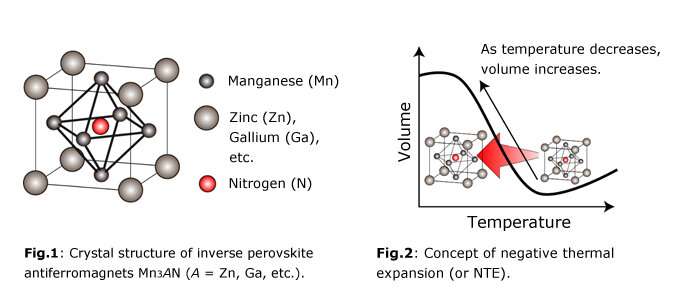Mechanism behind magnetism-driven negative thermal expansion (NTE) explained for the first time

Computers, cell phones and other devices are built from many small parts and components that are prone to poor performance and damage caused by overheating. As such, there is a market demand to develop machine parts that can resist damage and changes in size and length due to heat.
It's commonly believed that materials expand upon heating and contract upon cooling. In reality, some materials behave the other way around, i.e., expanding upon cooling and vice-versa, an unusual phenomenon known as negative thermal expansion (NTE). NTE materials have thus come under the spotlight in research, because by exploiting their characteristics and using them in combination with non-NTE materials, developers could make materials that are even less heat-sensitive than before. Unfortunately, the mechanisms behind NTE are not well understood.
Now, for the first time, a study led by Professor Masahito Mochizuki at Waseda University and graduate student Masaya Kobayashi from Aoyama Gakuin University has provided a theoretical explanation of the NTE phenomenon by examining NTE in inverse perovskite antiferromagnets Mn3AN (A = Zn, Ga, etc.). The theory could not only help scientists and developers understand the mechanism behind NTE, but also allow them to predict and identify possible candidate materials that exhibit NTE—a crucial process in research and development.
An electron has an angular momentum called "spin" originating from its rotation. During cooling, the spin vectors of electrons that orbit around the manganese (Mn) ion present in Mn3AN would align themselves in a specific fashion called nonplanar antiferromagnetic order. As temperature decreases, the Mn3AN material expands in volume. Believing that there is a close relationship between the electron spin alignment and the negative thermal expansion phenomenon in Mn3AN, Professor Mochizuki and his team decided to investigate the correlations between the two to understand the NTE mechanism by numerically reproducing the crystal-volume expansion upon cooling triggered by the nonplanar antiferromagnetic order.
"In our study of inverse perovskite antiferromagnets Mn3AN, we have revealed that the mechanism is not specific to the inverse perovskites, but might be expected in other crystal structures. Specifically, antiferromagnets in which antiferromagnetic contribution from direct exchange paths and ferromagnetic contribution from indirect 90 degree paths compete with each other are potential candidates that could exhibit NTE," says Professor Mochizuki.
Professor Mochizuki and his team believe that the above prediction will be a useful guide to search for new NTE materials because there is no reliable way to seek or identify magnetism-driven NTE materials at present. "Although the existence of such competition is not a sufficient condition but a necessary condition for emergence of the magnetism-driven NTE, the search for compounds that satisfy this condition is a good strategy to discover new NTE materials with profound effects," says Professor Mochizuki.
More information: Masaya Kobayashi et al. Theory of magnetism-driven negative thermal expansion in inverse perovskite antiferromagnets, Physical Review Materials (2019). DOI: 10.1103/PhysRevMaterials.3.024407
Provided by Waseda University





















